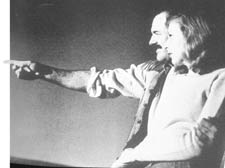|
|
 |

Martha Gellhorn with then husband Ernest Hemingway in Cuba |
Letters of a restless, but unique roving reporter
Martin Bell pays tribute to the 20th century's greatest foreign correspondent, Martha Gellhorn, who was fearless with her person and opinions.
The Letters Of Martha Gellhorn
Edited by Caroline MoorheadChatto and Windus, £30 order this book
At the age of 21, Martha Gellhorn set off from New York to Paris with two suitcases, a typewriter and $75 in her pocket. For the next seven decades she travelled restlessly, recording not just the life and times, but chiefly the wars, of the turbulent 20th century. She kept no diary but wrote thousands of letters. This book is a treasury of them.
Her classic pose, which she strikes on its cover, was that of a woman with a pen in one hand, a cigarette in the other and a far-away look in her eyes. She was the absolute type of the roving reporter, an endangered species but no longer quite extinct.
In that role, she speaks to us appealingly across the years, as from Paris in 1936: “This afternoon I am going to the riots. What I love about France is their sense of order inside a framework of anarchy.”
She was a woman of strong opinions and affections to match. Of her husbands and lovers the most famous was Ernest Hemingway, whom she met in Key West when he was already an established writer, and to whom she was married for four of the eight years that they spent, more or less, together.
She was attracted by his way with words: “He’s an odd bird, very lovable and full of fire and a marvellous story teller.” After it was over she was neither bitter nor sentimental, but faithful to his memory.
She wrote of her next husband, Tom Matthews: “Tom is not Ernest… All is well: no purdah, no chains, no scenes, no one shooting out of the living room window.” Her letters are a biographer’s gold-mine.
Had all our literary lions kept such company, we would see their strengths more clearly through their weaknesses.
The letters are more than communications between friends, but assume and require a wider audience. They are bridges between her time and ours, as fresh off the page as if she had written them yesterday.
This, for instance, to Adlai Stevenson in December 1962 on the death of her friend Eleanor Roosevelt: “Life closes over the dead like quicksand; they sink into death and the surface is smooth above them. We are of course all moving on that quicksand.”
When troubled, which was as often as not, she lost herself in her work: “I like working. In the end it is the only thing which does not bore or dismay me, or fill me with doubt.”
She spent a lifetime rejecting the ease and privilege to which she was born. Discomfort, hardship and danger were no deterrents, but attracted her dangerously. “I don’t enjoy pleasure,” she wrote.
And she was not alone among foreign correspondents in finding more satisfaction in journalism than in her personal life. But she got there first and expressed her feelings with typical, blinding honesty.
Something else she did, which to me was her greatest achievement, was to dismiss the notion of journalists as remote, detached and morally neutral chroniclers of their times.
To the end, in 1998, she retained a profound sense of right and wrong and of lines that were not to be crossed. “The only danger is of seeing too much and finally feeling too little.”
Influential as she was, Martha Gellhorn was not as much a mover and shaker as she wished to be. From her first assignment for the Albany Times Union to her later work for Colliers magazine, she never quite had the platform that her talents deserved.
At the height of the Vietnam War, which she strongly opposed, she described the New York Times columnist Anthony Lewis as someone she envied more than anyone else on earth: “To have a voice and big powerful places to make it heard.” She told him: “There is a new US policy, unique: it is, scorch their earth.”
Heaven knows what she would have made of the lawlessness and adventurism of George W Bush and the New American Century. Mercifully for her, she pre-deceased them.
I was honoured to meet her shortly before her death at the age of 90. A vivacious, bird-like figure with an unquenchable spirit.
She is often spoken of a role model for those women like Kate Adie of the BBC and Christiane Amanpour of CNN who have succeeded in the previously all male craft of war reporting.
But she was more than that. She was a model for all of us who came afterwards and tried to do as she did. Her qualities of courage and independence of mind are never more needed than today, in an age of embedded reporting, intimidated journalism and the domination of mainstream news by global corporations.
|
 |
|


